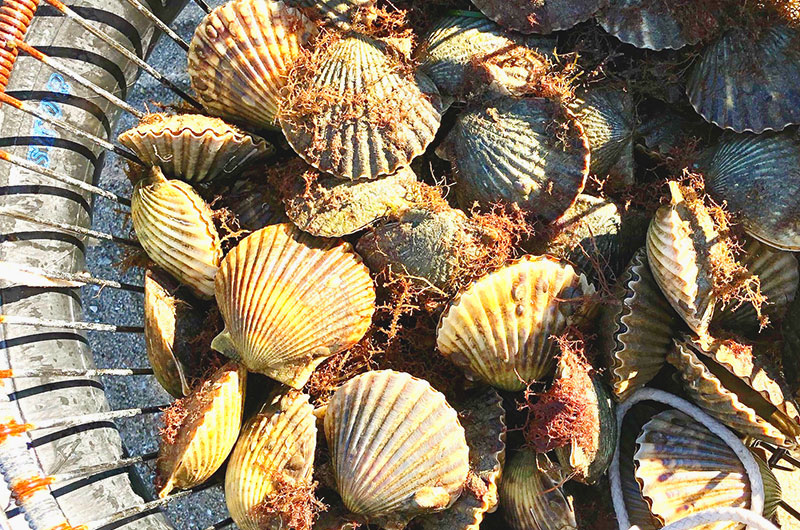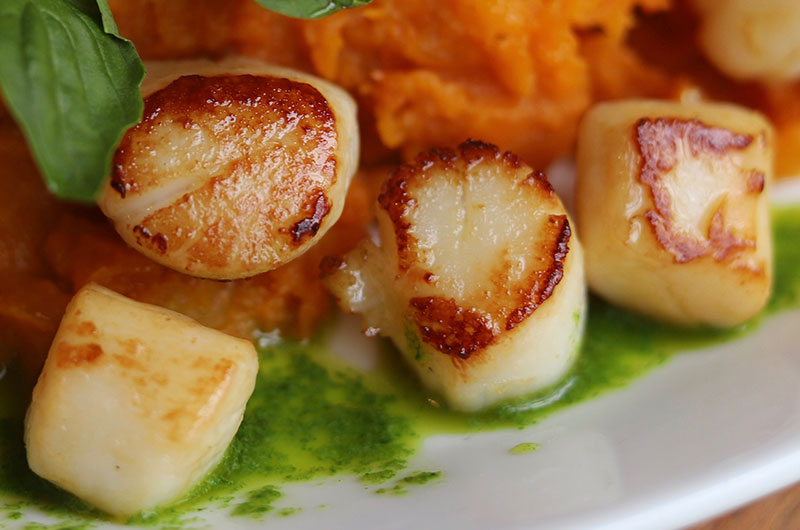It is 6:30 a.m. and twenty-two degrees as we get ready to head into Lagoon
Pond in an open boat one December
day. We’re fishing for scallops; actually, we’re going to watch commercial fishermen (and couple) Bill Alwardt and Betty Mansure fish for scallops. We want to find out how bay scallops get from the bottom of the sea to the fish market
before landing on our plates.
By law, it must be at least twenty-eight degrees to go scalloping. That’s the
temperature at which salt water freezes – at lower temperatures the smaller seed scallops brought up with larger scallops freeze. By 7:15, the temperature reaches 27.9 degrees and the eighteen-foot Whitecap IV starts across the Lagoon. Whitecap is the only scalloping boat
fishing until late in the morning, when another boat appears and works close by.
Betty and Bill say they have gotten dressed for a day of scalloping when the wind was gusting to fifty miles an hour. “We still get up and try,” they say. As with most self-employed Islanders, initiative is everything: if they don’t suit up and go, they don’t make money. When they must venture out, they layer: long underwear, flannel-lined pants, special wool socks – “$13 apiece!” says Betty – under insulated boots. A rubber foul-weather jacket and gloves finish it all off.
Betty and Bill are among the twenty-one commercial scallopers
who have permits in Oak Bluffs. They met scalloping in 1981; now they’re in it together. When Bill met Betty, he says, “She had her own boat and pulled by hand. She’s probably the only girl who bought her own boat and fished on her own.”
“He’s really the best scalloper I’ve ever seen,” says Betty. His knowledge of the contours of the pond, the depths of various holes, the best-producing spots, is amazing. She stops working to talk and Bill gives her a look. “He can’t fire me,” she laughs. “We bought the boat together.”
The scallop rigging consists of a sixty-pound pan dredge fitted with a chain bag that’s lowered into the water to depths of ten to twenty feet. Bill skippers the boat, towing the dredge for about five minutes before raising and moving it over to a table that spans the deck. He lifts and dumps the contents, freighted with a mass
of seaweed, rocks, scallop shells, empty shells, and the occasional
small fish or green crab.
Betty starts culling – sorting through the pile, pulling out the adult scallop shells and putting them into the empty bushel basket on deck. What’s left is pushed back into the pond. The first two tows yield few scallops; it looks like it’s going to be
a long morning. But the third haul is better, filling maybe a third of the
first of six bushel baskets. Betty gently shakes the basket to let the scallops settle, which allows her to fit a lot more in.
Each commercial fisherman is
allowed three bushels a day – on this cold morning, a combined six bushels for Betty and Bill. They hope to get forty-two to forty-five pounds of scallops, which will bring in $11 a pound from Louis Larsen at The Net Result in Vineyard Haven. Two dollars of the eleven will go to the cutter – the person who opens the shell and removes the scallop muscle. There are additional expenses, of course, such as gas and boat maintenance. Betty and Bill can’t rely on scalloping alone to make a living. They’re on the water from April to December during conch season, which can take them into Nantucket Sound daily. The conch is sent to markets in Japan. They also fish for black sea bass during May and again in August.
As they work, the couple discusses changes in the fishing industry, dead areas in the Lagoon that don’t produce scallops anymore, and how few, if any, young people are entering this business. The boat turns wide circles; Bill lowers and raises the dredge again and again. Each time, it’s like looking for treasure, waiting to see what comes up. The temperature remains frigid. Four bushels get filled. “We’re over the hump,” says Betty.
“Fishing is hard work,” she says. “I’m not one to exercise. Here, you’re forced to.” It also has its benefits. “You’re your own boss,” says Bill.
“I like the quiet. You don’t see the crowds – you see the sun rise.” As challenging as scalloping looks to a newcomer, Betty and Bill consider
this their easy season. They’re often done for the day by 10 or 11 a.m. Conch season usually means
thirteen-hour days.
More tows, and finally, quota.
We motor back to the lot near the drawbridge along Beach Road, where we started. “You did good,” they tell me, as I look forward to thawing. Bill lifts out the bushels and they each grab a side, carrying their bushels together, one by one, to their truck, their red and orange rubber outer gear silhouetted against the blue winter sky.
It’s late morning, but still quiet by the pond. I feel as if I’ve just stepped out of the modern world and experienced some older way of life, where a product is procured by an individual’s effort, not mass-produced in a factory. I wonder if this way of life will go the way of the family farm. I certainly hope not. Because even if the scallop survives the environmental abuse we are dealing it today, who will be there to take it to market, so that we can continue to look forward each fall to the sweet, succulent bay scallop?
State of the Bay Scallop
New England scallops, loved for their creaminess and complex flavor, come in two very different species. The more common sea scallop is the largest scallop and obtainable year-round. The medium- to smaller-size bay (or cape) scallop is available only a few months off-season and is considered the more highly prized – tender, sweet, and impeccably fresh.
Though the average adult bay
scallop can spawn over one million eggs, it’s having a rough time these days. Historically productive spots along the New York, Connecticut,
and Rhode Island shores yield virtually no bay scallops at all. Bay scallop populations on Cape Cod bay are
severely depressed. The causes are many – most of them environmental – though no one can pinpoint exactly which is the greatest. Only Nantucket and the Vineyard reliably produce
this precious commodity.
But even here, the decline of the bay scallop – and the attrition of the people who fish for them – is evident to all. “The Vineyard is not anything like it used to be, but compared to other areas, we still have a viable
fishery,” says Rick Karney, a marine biologist and director of the Martha’s Vineyard Shellfish Group, which spawns and grows millions of seed for five of the six Island towns each year. “I think it’s constantly going to be a battle to maintain them. I’ve been here twenty-seven years, and the population (of humans) has increased dramatically. It seems like the greater the
human population, the worse it is for the scallops. Those densely populated areas off-Island are the places don’t have the scallop anymore.”
Algae blooms known as brown tide, pollution from midwestern smokestacks, and especially nitrogen seeping down to the water from lawn fertilizers and septic systems – each of these pollutants affects the saltwater ponds where bay scallops live.
In the summer of 2003, Lagoon
Pond, lying on the inland side of Beach Road in Vineyard Haven, was the scene of a massive die-off of infant seed, which was being tended by the Martha’s Vineyard Shellfish Group. The pond is taking in too much nitrogen, most of it probably from septic systems, according to Oak Bluffs shellfish constable and marine biologist David Grunden. The nitrogen feeds algae, which blooms and blocks out sunlight required by bottom-growing eelgrass. Eelgrass is essential scallop habitat.
Still, the Shellfish Group, located
at the upper end of the afflicted
Lagoon Pond, soldiers on. Last season
it raised and released some six million scallop seeds, or spat, into six saltwater ponds around the Vineyard – Cape Pogue, Katama Bay, Sengekontacket, the Lagoon, Lake Tashmoo, and Menemsha ponds. These seedlings add to the bay scallops spawned
naturally in the ponds.
“The Martha’s Vineyard Shellfish Group has been in the forefront of municipal scallop aquaculture and scallop research for over twenty years,” says Sandra McFarlane of the Barnstable County Cape Cod Extension, which recently produced a report on bay scallops in Massachusetts waters. “They have perfected hatchery techniques for their particular operation and routinely produce millions of juvenile scallops. Their work has had widespread exposure throughout the international shellfish community.”
The family-permit season generally opens first, followed by the commercial season in mid- to late October. The Vineyard seasons open before Nantucket and levels of scallops brought in from both Islands tend to run neck and neck, with the Vineyard sometimes outproducing Nantucket, and sometimes the other way around – kind of like the football rivalry between the two Islands, says Karney.
For more information on how to cook bay scallops, read The Short Story of Cooking Bay Scallops.








